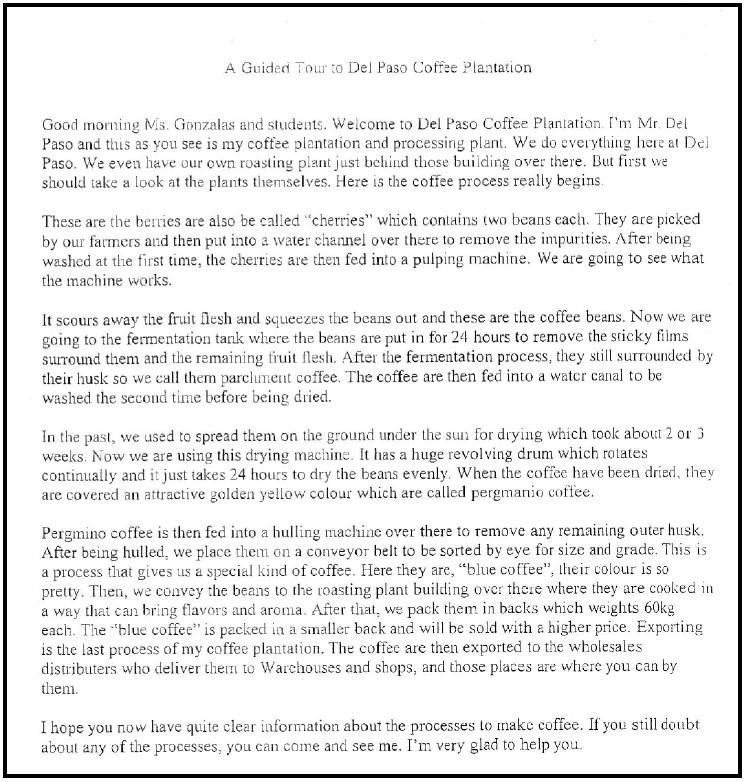Student information
The student comes from Vietnam and speaks Vietnamese. She has had age equivalent schooling in Vietnam where she also took English classes. She spent 20 weeks in an English language school before attending secondary school. She is in Year 10.
Task
Students have been learning about how coffee is produced with the intention of having them write a text that required the passive voice to be used. They were asked to imagine they had to give a talk to a group of Year 10 students about the production and manufacture of coffee. They were given the start of the script and were asked to finish it. The task was scaffolded with a picture sequencing and vocabulary task and also with supplementary information. This is the student's first draft completed in class.

Text
A Guided Tour to Del Paso Coffee Plantation
Good morning Ms. Gonzalas and students. Welcome to Del Paso Coffee Plantation. I'm Mr. Del Paso and this as you see is my coffee plantation and processing plant. We do everything here at Del Paso. We even have our own roasting plant just behind those buildings over there. But first we should take a look at the plants themselves. Here is the coffee process really begins.
*This is the starter paragraph given to the student and is not the student’s own writing.
These are the berries are also be called “cherries” which contains two beans each. They are picked by our farmers and then put into a water channel over there to remove the impurities. After being washed at the first time, the cherries are then fed into a pulping machine. We are going to see what the machine works.
It scours away the fruit flesh and squeezes the beans out and these are the coffee beans. Now we are going to the fermentation tank where the beans are put in for 24 hours to remove the sticky films surround them and the remaining fruit flesh. After the fermentation process, they still surrounded by their husk so we call them parchment coffee. The coffee are then fed into a water canal to be washed the second time before being dried.
In the past we used to spread them on the ground under the sun for drying which took about 2 or 3 weeks. Now we are using this drying machine. It has a huge revolving drum which rotates continually and it just takes 24 hours to dry the beans evenly. When the coffee have been dried, they are covered an attractive golden yellow colour which are called pergmanio coffee.
Pergmino coffee is then fed into a hulling machine over there to remove any remaining outer husk. After being hulled, we place them on a conveyor belt to be sorted by eye for size and grade. This is a process that gives us a special kind of coffee. Here they are, “blue coffee”, their colour is so pretty. Then, we convey the beans to the toasting plant building over there where they are cooked in a way that can bring flavours and aroma. After that, we pack them in backs which weights 60kg each. The “blue coffee” is packed in a smaller back and will be sold with a higher price. Exporting is the last process of my coffee plantation. The coffee are then exported to the wholesales distributers who deliver them to Warehouses and shops, and those places are where you can by them.
I hope you now have quite clear information about the processes to make coffee. If you still doubt about any of the processes, you can come and see me. I’m very glad to help you.
This sample of student work demonstrates that the student can:
- Use verb forms appropriate to text type
(VCEALL728)
-
Construct extended sentences using simple relative clauses and a range of common conjunctions
(VCEALL727)
Overall, this student can also:
- Plan and sequence information for a specified text
(VCEALL723)
- Use basic knowledge of grammatical features at the sentence level to argue, persuade, describe, classify, explain or instruct
(VCEALL726)
- Write cohesive texts for a range of purposes
(VCEALL724).
Possible next steps for this student's learning
- Editing her writing for the passive voice by highlighting all the verbs and verb phrases and changing them if necessary
(VCEALL728)
- Creating a presentation on coffee production and labelling each image with key phrases written in the passive voice
(VCEALL726)
- Practising relative pronouns
(VCEALL727)
- Practising and delivering a talk on coffee production
(VCEALL686).
Pathways and transitions considerations
A Year 10 student who is working within the range of Level C3 in any one language mode is not ready to transition to the English curriculum regardless of their proficiency in the other two language modes. This student will continue on Pathway C of the EAL curriculum.